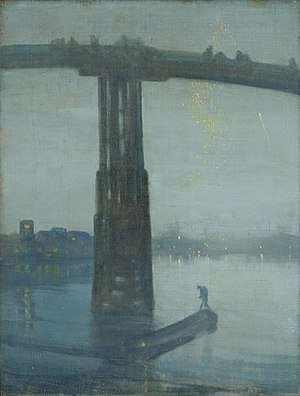Nocturne (painting)
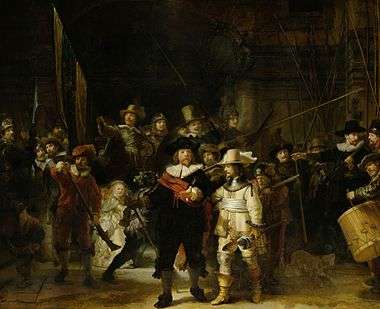
Nocturne painting is a term coined by James Abbott McNeill Whistler to describe a painting style that depicts scenes evocative of the night or subjects as they appear in a veil of light, in twilight, or in the absence of direct light. In a broader usage, the term has come to refer to any painting of a night scene,[3] or night-piece, such as Rembrandt's The Night Watch.
Whistler used the term within the title of his works to represent paintings with a "dreamy, pensive mood" by applying a musical name.[4] He also titled (and retitled) works using other terms associated with music, such as a "symphony", "harmony", "study" or "arrangement", to emphasize the tonal qualities and the composition and to de-emphasize the narrative content.[5] The use of the term "nocturne" can be associated with the Tonalism movement of the American of the late 19th century and early 20th century which is "characterized by soft, diffused light, muted tones and hazy outlined objects, all of which imbue the works with a strong sense of mood."[6] Along with winter scenes, nocturnes were a common Tonalist theme.[7]Frederic Remington used the term as well for his nocturne scenes of the American Old West.[8][9]
Rembrandt’s nocturnes
In northern Europe, the Dutch Golden Age produced one of the greatest artists of all time. The first artist to paint scenes on a regular basis in the nocturne mode was Rembrandt van Rijn (1606–1669). Many of his portraits were also painted using a nocturne method. As in The Mill (1645), most of his landscapes were painted to evoke a sense of the nocturne, which could be expressed in either a calm or stormy manner.[10]
Night scenes by Rembrandt
 Christ In The Storm On The Sea Of Galilee, 1633, depicts a nocturne scene evoking a sense of danger
Christ In The Storm On The Sea Of Galilee, 1633, depicts a nocturne scene evoking a sense of danger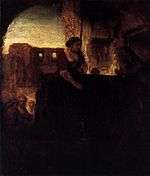 Christ and the Woman of Samaria, 1659,
Christ and the Woman of Samaria, 1659,.jpg) The Polish Rider, 1655,[11]
The Polish Rider, 1655,[11]
Nocturnes by James Abbott McNeill Whistler
“Nocturne” was a term that was normally applied to certain types of musical compositions before James Abbott McNeill Whistler (1834–1903), inspired by the language of music, began using the word within the titles of many of his works,[14] such as Nocturne in Blue and Silver (1871), in the collection of the Tate Gallery, London, United Kingdom.[15]
 Nocturne in Blue and Gold: Valparaiso Bay, 1866
Nocturne in Blue and Gold: Valparaiso Bay, 1866 Nocturne in Gray and Gold, Westminster Bridge, c. 1871-1874
Nocturne in Gray and Gold, Westminster Bridge, c. 1871-1874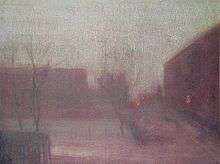 Nocturne Trafalgar Square Chelsea Snow, 1876
Nocturne Trafalgar Square Chelsea Snow, 1876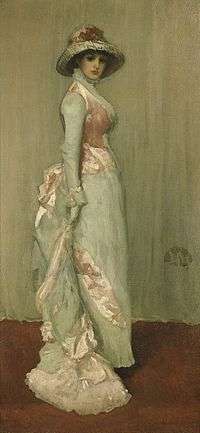 Nocturne in Pink and Grey, Portrait of Lady Meux, 1881-1882
Nocturne in Pink and Grey, Portrait of Lady Meux, 1881-1882
Frederic Remington’s nocturnes
Frederic Remington (1861-1909) is so identified for his nocturne scenes of the American Old West[16] that they were celebrated in 2003-2004 with an exhibition, Frederic Remington: The Color of Night, co-organized and shown in turn by the National Gallery of Art, Washington, D.C., and the Gilcrease Museum, Tulsa, Oklahoma.[17] The exhibition also generated a colorful book of the same title and travelled to the Denver Art Museum in Denver, Colorado. Remington painted many of his nocturnes in the last years of his life, when he was transitioning from a career as an illustrator to that of a fine artist and had chosen Impressionism as the style in which he worked at the time. One example of his work is The Stampede (also known as The Stampede by Lightning, 1908).

Nocturnes by Frederic Remington
The paintings pictured in the gallery below are in order of date completed, left to right:
 Pretty Mother of the Night—White Otter is No Longer a Boy c. 1900, private collection
Pretty Mother of the Night—White Otter is No Longer a Boy c. 1900, private collection The End of the Day c. 1904, Frederic Remington Art Museum, Ogdensburg, New York
The End of the Day c. 1904, Frederic Remington Art Museum, Ogdensburg, New York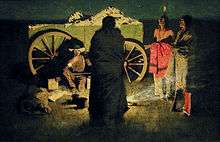
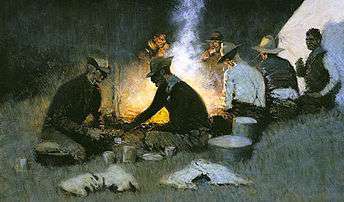 The Hunters' Supper c. 1909, National Cowboy & Western Heritage Museum, Oklahoma City, Oklahoma
The Hunters' Supper c. 1909, National Cowboy & Western Heritage Museum, Oklahoma City, Oklahoma Moonlight Wolf c. 1909, Addison Gallery of American Art, Andover, Massachusetts
Moonlight Wolf c. 1909, Addison Gallery of American Art, Andover, Massachusetts
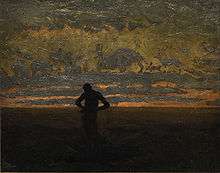

Night scenes by American Impressionists and other American Realists
.jpg)
- Thomas Cole (1801–1848), Moonlight (1833–34)
- George Inness (1825-1894), Pool in the Woods, 1892, Worcester Art Museum, Worcester, Massachusetts
- John Henry Twachtman (1853-1902), Canal Venice[19] c. 1878, private collection
- John Henry Twachtman (1853–1902), L'Etang[20] c. 1884, private collection
- Albert Pinkham Ryder (1847–1917), Death on a Pale Horse (The Race Track) c. 1910, The Cleveland Museum of Art, Ohio
- Frank Tenney Johnson (1874-1939), Rough Riding Rancheros[21] c. 1933
- Edward Hopper (1882-1967), Nighthawks, 1942, Art Institute of Chicago, Chicago, Illinois
Night scenes by American Impressionists and American Realists
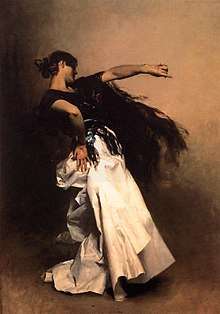 John Singer Sargent, Spanish Dancer, 1879–1880, The Hispanic Society of America, New York
John Singer Sargent, Spanish Dancer, 1879–1880, The Hispanic Society of America, New York.jpg) Childe Hassam, Winter, Midnight, 1894
Childe Hassam, Winter, Midnight, 1894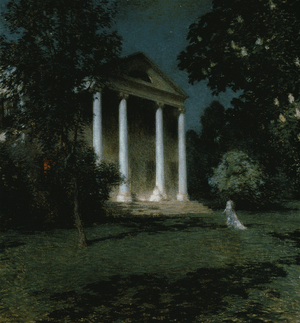 Willard Metcalf, May Night 1906, Corcoran Gallery of Art
Willard Metcalf, May Night 1906, Corcoran Gallery of Art J. Alden Weir, The Bridge Nocturne aka Nocturne Queensboro Bridge, 1910, Hirshhorn Museum and Sculpture Garden
J. Alden Weir, The Bridge Nocturne aka Nocturne Queensboro Bridge, 1910, Hirshhorn Museum and Sculpture Garden
Night scenes by artists of other movements
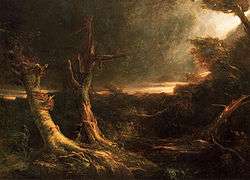
Other artists who also created nocturne scenes are:
- Jacob van Ruisdael (1628–1682), Landscape with Church (circa 1660)]
- Jacob van Ruisdael, Landscape (circa 1665)
- Augustus Leopold Egg (1816–1863), Past and Present Number Three (circa 1853)]
- John LaFarge (1835-1920), The Lady of Shalott (1862)
- Edgar Degas (1834–1917), Interior (nicknamed The Rape) (1868–69), Philadelphia Museum of Art[22]
- Vincent van Gogh (1853-1890), Starry Night Over the Rhone (1888)
See also
- Artists who have used the term for a series of their works
- Night in paintings (Eastern art)
- Tonalism
- Night photography
References
- ↑ Whistler versus Ruskin, Princeton edu. Archived June 16, 2010, at the Wayback Machine. Retrieved June 13, 2010
- ↑ , from the Tate, retrieved April 12, 2009
- ↑ Lawton, Denis. (1992). Education And Politics For The 1990s: Conflict Or Consensus? (edition reprint). Psychology Press. p. 150. ISBN 0750700793.
- ↑ "Tonalism and the "Nocturne". Detroit Institute of Arts. Retrieved 2012-09-01.
- ↑ Anderson, Ronald and Anne Koval. (2002). James McNeill Whistler: Beyond the Myth. De Capo Press. p. 186. ISBN 0-786-71032-2. (Note: need to verify this was the edition used.)
- ↑ Marter, Joan. (2011). The Grove Encyclopedia of American Art, Volume 1 Oxford University Press. p. 54. ISBN 0195335791.
- ↑ Conrads, Margaret C. (1990). American Paintings and Sculpture at the Sterling and Francine Clark Art Institute. Contributor: Sterling and Francine Clark Art Institute. Hudson Hills. p. 148. ISBN 1555950507.
- ↑ "Artistic experiments". National Gallery of Art. Retrieved 2012-09-01.
- ↑ "18 images of Remington's nocturnes on 18 web pages". National Gallery of Art. Retrieved 2012-09-01.
- ↑ Robert Hughes (11 February 2006). "The Enduring Genius of Rembrandt". The Guardian.
- ↑ Collections.frick.org
- ↑ Moore, Susan (2003-11-01), "Guardian of the nation's treasures", The Spectator, London
- ↑ Steiner, Wendy (January 1993), "A Pot of Paint: Aesthetics on Trial in Whistler v. Ruskin", Art in America, retrieved 2009-05-26
- ↑ "Images of many of Whistler's nocturne paintings, and some by his contemporaries, can be seen at this website for the Detroict Institute of Arts". Dia.org. Archived from the original on 2012-07-18. Retrieved 2012-09-01.
- ↑ Ronald Anderson and Anne Koval, James McNeill Whistler: Beyond the Myth, Carroll & Graf, New York, 1994, ISBN 978-0786701872
- ↑ "18 images of Remington's nocturnes on 18 web pages at the National Gallery of Art". Nga.gov. Retrieved 2012-09-01.
- ↑ "''The Color of Night'' exhibition website with extensive information and images about Frederic Remington and his paintings". Nga.gov. Retrieved 2012-09-01.
- ↑ Tamsquare.net
- ↑ Johnhtwachtman.com
- ↑ Artnet.com
- ↑ Cowboyindian.com
- ↑ Philadelphia Museum of Art
Further reading
- Holden, Donald. Whistler: Landscapes and Seascapes. Lakewood, New Jersey: Watson-Guptill Publications, 1984.
- Anderson, Nancy with Alexander Nemerov and William Sharpe. Frederic Remington: The Color of Night. Washington, D.C.: National Gallery of Art, 2003.
- Sharpe, William C. New York Nocturne: The City After Dark In Literature, Painting, and Photography, 1850-1950. Princeton, New Jersey: Princeton University Press, 2008.
- Simpson, Marc and others. Like Breath on Glass: Whistler, Inness, and the Art of Painting Softly. Williamstown, Massachusetts: Sterling and Francine Clark Art Institute, 2008 (printed by Yale University Press).

